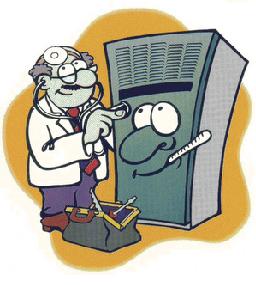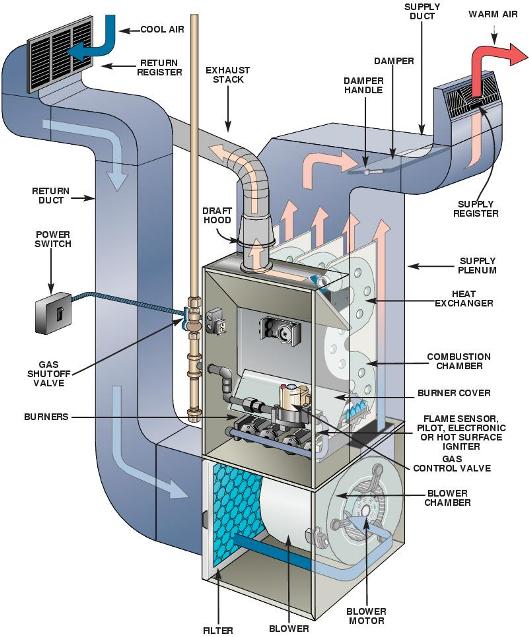|
FORCED AIR HEAT: FORCED AIR FURNACES
| |||||
|
|
Traditional gas-fired forced air furnaces can be found anywhere from 40,000 btu to 165,000 btu for residential applications. The blowers are also rated from 2-ton to 5-ton blowers. The capacity of the blower is especially critical if the furnace pulls double-duty and provides air distribution for a central air conditioner.
In the days of old, not so long ago, forced air furnaces were equipped with a standing pilot. This pilot was a small flame, which ignited the burners on a call for heat. The pilot could consume as much as 2,000 btu/hr.
Furnaces available today no longer use a standing pilot and have been replaced with electronic ignition, spark ignitors, or hot surface ignitors.

Efficiency or AFUE
The change away from the standing pilot has helped raise furnace efficiencies. Ashrae claims a 16% energy savings once a natural draft furnace with a standing pilot has been replaced with a fan-assisted furnace with electronic ignition.
In the past, furnace efficiencies could be as low as 55% AFUE. The minimum allowable efficiency today is 80% AFUE.
AFUE means, "Annual Fuel Usage Estimate", or efficiency.
80% AFUE means that 80% of the fuel burned by an appliance is providing heat for the home. The other 20% is going up the flue and heating the outside.
By installing a furnace, which is rated at 94% AFUE, now 94% of your heating dollars is actually heating your home, and only 6% is lost to the outside.
Natural draft and fan-assisted furnaces are typically in the 80% AFUE range. These units are open, or atmospheric, combustion appliances.
A natural draft furnace relies upon heat rise and buoyancy to pull combustion air into the combustion chamber and force exhaust gases out the flue.
A fan-assisted furnace utilizes a small fan, or inducer to pull combustion air in, and force combustion products through the furnace.
What-is-hvac.com is an excellent source for heating systems and Building mechanical systems information.
Thornton Plumbing and Heating in Midvale, Utah are experts in their fields. Their forced air and radiant divisions are valuable resources when choosing comfort for your home.
Once we reach 90% AFUE or better, venting and combustion processes change a bit. These furnaces are direct-vent appliances, which means that both exhaust and intake air (combustion air) are piped directly to the outside. No indoor combustion air is utilized. The combustion chambers are sealed for better control of the combustion process.
These forced air furnaces are also known as condensing furnaces. A condensing furnace recovers waste heat from the exhaust gases, which would normally be sent out into the atmosphere. These units have a larger heat exchanger surface, which pulls heat from water vapor being produced during combustion.
These units produce condensate which must be disposed of. This condensate water is acidic.
Cast iron and plastic drains are usually acceptable for condensate disposal, but not galvanized drains.
Some municipalities have strict codes governing condensate disposal. Check with your local building authorities for proper disposal requirements.
Other Related Pages:
Air Handlers with Hot Water Coils
Modulating Gas Furnaces: Be the first one on your block
Electric Forced Air Furnaces
Air Handlers Fitted with Electric Heat Strips
Deadly Killers Amongst Us: Carbon Monoxide
Forced Air Furnaces: High Efficiency Direct Vent Condensing Furnaces
Quality Installation Checklist
10 Ways To Save Money on Your Heating and Air Conditioning
by Janet M. Slagell
Return to HOME
Please feel free to link to this page from your website. This page's URL is: http://www.perfect-home-hvac-design.com/forced-air-furnaces.html






























